| |
|
|
| |
The rental car is filled with gas and now safely back without a scratch. As are we. So now the story can safely be told. We were SUPPOSED to drive to the main checkpoint leading into Bethlehem on the West Bank, the Arab chunk of Israel.
Before 2000 ... before the second intifada and its terrorist bombings, you could drive unhindered between the Jewish and Arab districts of Israel on the edge of Jerusalem. But now there is this wall. And security gates. And you are not supposed to take an Israeli rental car across. |
|
| |
|
|
|
|
| |
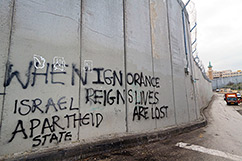
|
|
Graffiti on the security wall built to separate Jewish and Arab sectors of Israel. Upon completion, the barrier’s total length will be approximately 760 kilometres (470 mi). Supporters argue that the barrier is necessary to protect Israeli civilians from Palestinian terrorism, including the suicide bombing attacks that increased significantly during the Second Intifada, a period of intensified Palestinian–Israeli violence, which began in late September 2000 and ended roughly around 2005. Photo by Yvette Cardozo |
|
| |
|
|
|
|
| |
So we set out, eight of us ... seven women and a token guy ... in two cars equipped with a GPS we promptly named Jezebel (this was, after all, the Holy Land). Jezebel had this sweet Brit accent and this strange habit of telling us to take the second turn when she really meant get into the second lane before turning. Or something. We never did quite figure it out.
| |
|
|
| |
|
|
| |
Security wall at Rachel's Crossing checkpoint with artful graffiti
Photo by Kathy Hagood |
|
We turned and U-turned, and after a bit, found what we thought was the right checkpoint. It was cold and windy and rain was starting to fall. The lone Arab guard didn’t speak English. And there was this vegetable truck with two women in head scarves.
We thought the guard told us to continue on down the road. Surely we would find a second gate, a parking lot and our paid guide.
But, no. What we found soon enough was a city. And all the signs were in Arabic. And there were mosques. And LOTS of head scarves. |
|
| |
|
|
| |
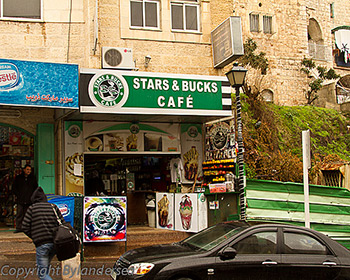
|
|
| |
Starbucks coffee shop knockoff in Bethlehem.
Photo by Debi Lander |
|
| |
|
|
|
|
| |
“Um, guys, I think we’re in Bethlehem,” one of the women said. After several U-turns and interesting encounters with assorted vehicles, we pulled to a curb, saw a man, rolled down a window and asked, “Do you speak English?”
“Quite well,” came the answer. We explained we were looking for the Church of the Nativity ... the very spot where Jesus was born.
“Ah,” the man said, pulling a neck tag from under his shirt. “I am an official Palestinian Ministry of Tourism guide.” His name was Walid Qurneth. He looked at the two cars with seven women. Eric, our token male, was inside a nearby shop asking for directions.
“Where is the man? Where is the man?” Walid asked plaintively. Apparently no decisions would be made until the man of our harem approved. When Eric emerged, I think he was close to kissing Walid on the cheek. |
|
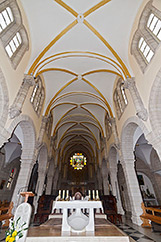 |
|
| |
And thus started my journey into Christian religious past. The church was just a few blocks away up some of the steepest streets I’ve ever seen, with the day’s winter deluge coursing down the slick sandstone cobblestones like a waterfall.
The church is huge, divided into three churches, actually (Greek Orthodox, Armenian, Roman Catholic). Steep stairs lead to chambers everywhere, but especially to THE spot. As a Jew, it was all amazing to me. Still, I could feel the Bible coming to life. |
|
Catholic Chapel in the Church of the Nativity in Bethlehem, West Bank, Israel. This church is a major Christian holy site, as it marks the traditional place of Christ's birth. It is also one of the oldest surviving Christian churches. |
|
| |
|
|
|
|
|
|
| |
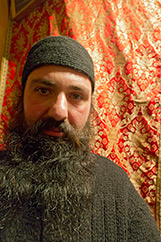 |
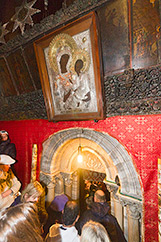 |
|
|
|
|
| |
Greek Orthodox priest |
Door to Grotto |
|
Grotto of the Nativity |
Grotto of the Nativity |
|
| |
The Grotto of the Nativity, a rectangular alcove beneath the church, is the Church of the Nativity's focal point. Entered by a flight of steps by the church altar, this is the cave that has been honored as the site of Christ's birth since at least the 2nd century.This is where it is believed the three wise men greeted Baby Jesus. The Church of the Nativity in Bethlehem, West Bank, Israel, is a major Christian holy site, as it marks the traditional place of Christ's birth. It is also one of the oldest surviving Christian churches. |
|
| |
|
|
| |
In one corner, in a small alcove that actually looks like a fireplace, it is said Jesus was born. You can lean in and find the metal emblem that marks the center. Then over there in another alcove, Mary kept baby Jesus warm in the manger, and in yet another alcove is the place where they greeted the Wise Men bearing gifts.
I stopped to speak briefly with a Greek Orthodox priest who shares this holy place with so many visitors, speaking softly and looking at the crowds with sad, serious eyes. Hordes of the faithful pressed in, flowing down the stairs in a breathless tidal wave of bodies.
This is the part of the Bible that is not really familiar to me but, slowly, I was beginning to understand just a bit of it ... the history, the devotion, the crowds of the faithful. People knelt before the holy spots, rubbing them gently with their fingertips, sometimes rubbing a scarf, or even a bottle of drinking water. I asked why and was told it blesses the objects. And of course, the people.
We squeezed with the crowds from chapel to memorial spot to chapel. And suddenly, there was a sound. Music. An evangelical group from Texas singing “Silent Night.” In January, yet. The melody seemed to soak into the very walls. It was weird but also a sacred moment.
And then we were again outside, back on the steep streets with a full inch of flowing water drowning our shoes. And into Walid’s brother’s gift shop.
Of course there was a gift shop.
Walid's brother had large glasses of sweet sage tea waiting for us. There were shelves of religious objects, some of them incredibly tacky (Jesus ballpoint pens), some breathtakingly beautiful (olive wood bibles). Yes, we dropped a wad.
Walid’s brother, Adel Korna, explained that the checkpoint we accidentally used (one of at least half a dozen between the Israeli and Arab sectors) was actually at Hebron. “You can’t go back that way,” he added. “It’s snowing there now.” Yes, we believed him. It was sleeting down here in the city. We got directions to take us back to the 'real' checkpoint, called Rachel's Crossing, with the real shivering, humorless (no wonder...they were freezing) Israeli guards.
As we prepared to leave, Adel smiled wide. “You are all now my friends. My family. Next time you are here ... you have my card ... call me and you will eat dinner in my house. A real, proper Arab dinner.”
I have no doubt he meant it, but more to the point, the trip ... even if we blundered into Bethlehem ... was a revelation for me on the spirituality of religious devotion. |
|
| |
|
|
|
|
| |

|
|
Nativity scene outside the Church of the Nativity in Bethlehem, West Bank, Israel. This church is a major Christian holy site, as it marks the traditional place of Christ's birth. It is also one of the oldest surviving Christian churches. |
|
| |
|
|
|
|
| |
INFO BOX
Israeli rental cars are not supposed to be driven into the West Bank because they are not covered by insurance in Arab sectors. And traffic anywhere in Israel can be dicey. At the official checkpoint, called Rachel's Crossing, there is a large parking lot. Most people arrange for a guide from the other side to pick them up in a car or van after they have walked across. If we had found the right gate and our arranged guide, it would have cost us $100 for the eight of us to be driven to the church and guided around it.
Walid Qurneth is an excellent guide and his brother’s gift shop, Adel Souvenir Store, has a nice assortment of religious souvenirs.
For Walid: Contact him through his brother's store, phone 972-276-4584, email, moh_a_korna@hotmail.com
For information on israel: www.goisrael.com |
|
| |
|
|
|
|
|